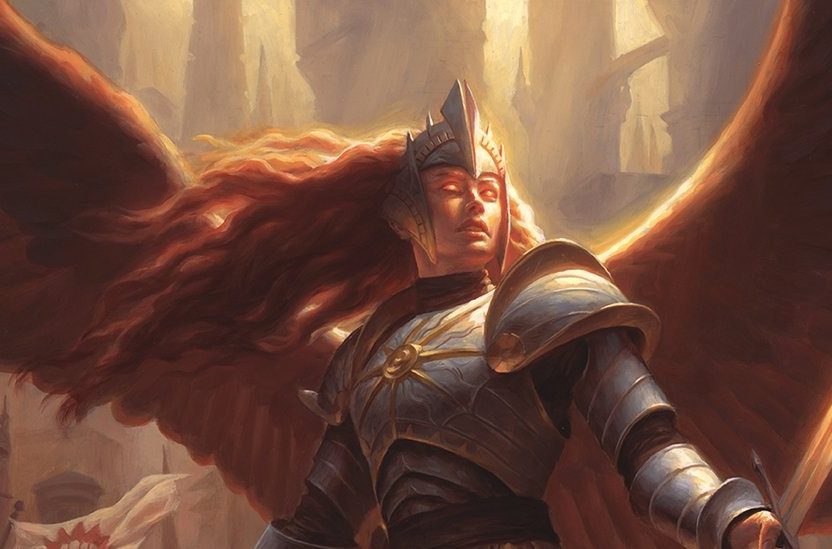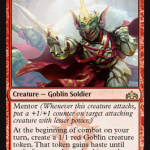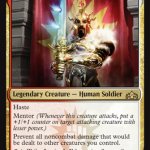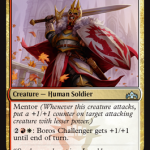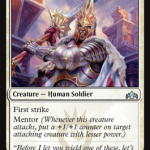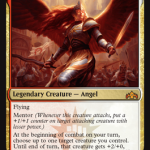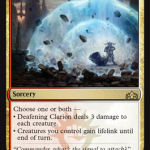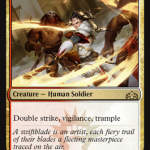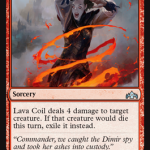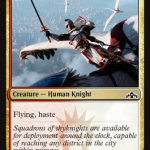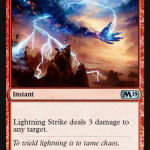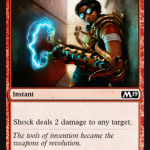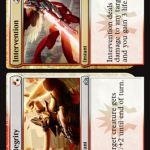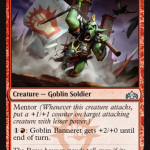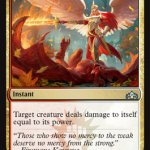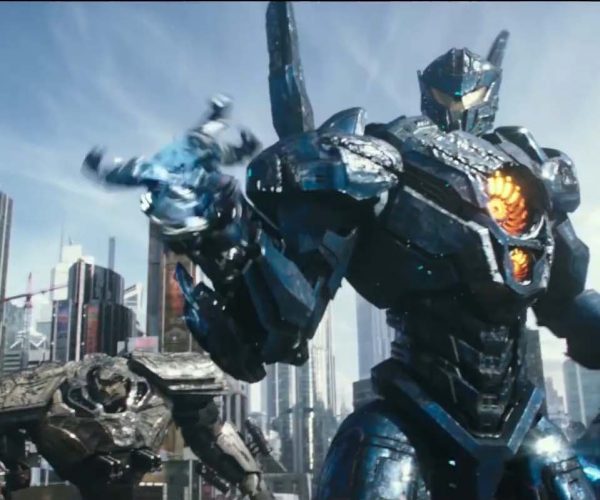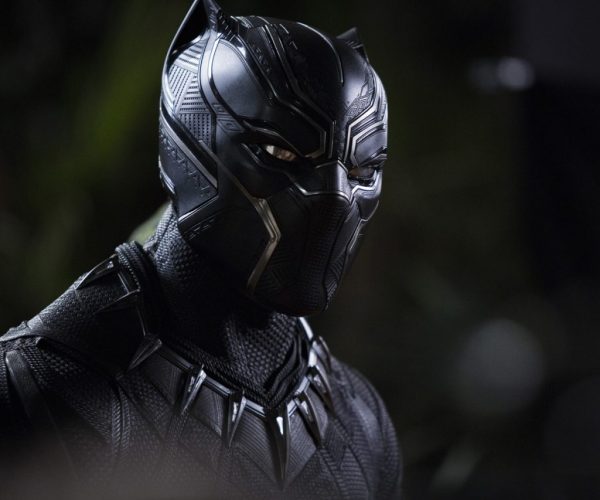After three weeks of pouring all of my free Magic Arena resources into a Boros Mentor deck and a pummeling my way through hundreds of matches, I think I’m ready to write a guide on the deck.
Based on my experiences, here is the best advice I can give on playing Boros Mentor in Standard on Magic Arena.
Play as many effective mentors as possible
It goes without saying that you want some mentors in your mentor decks. Otherwise… what’s the point? Without cards that use the mechanic, you might as well call this deck Red/White Aggro.
However, the more important decision is choosing the targets for the mentor ability. Getting value out of combat is the lifeblood of the deck, and without constantly pumping up your squad through repeated combat, you’re likely doomed to losing with nothing but a few wimpy 2/2 and 2/3 creatures on the board.
While there some obvious targets out there you’ll want to pour counters on, I’m finding that the best targets are actually other mentors. With a mentor on the board each and every combat, you’re either guaranteed a chance to power one of them up or at last control a 3/3 or a 3/4 creature that you paid two mana for.
Not bad. Not great, but not bad.
Choose your mentors wisely, don’t just play the common ones because they are mentors. I’ve tried them all, and none of them are effective enough to win the game like the uncommon and rare mentors are.
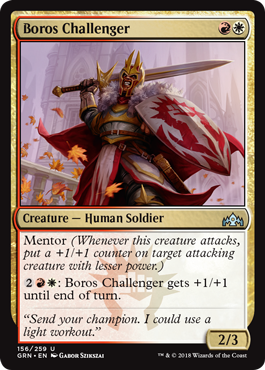
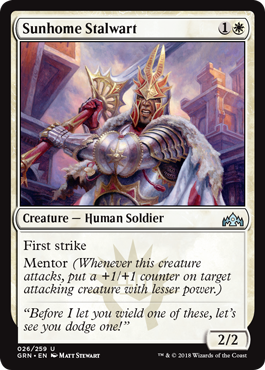
Yes and yes, play a playset of both of these. Boros Challenger is better since it doesn’t die to Shock, but Sunhone Stalwart is effective against a lot of 2-toughness creatures. A single mentor +1/+1 counter turns these cards into threats and even pushes Boros Challenger out of range of all Red removal… except for Lava Coil.
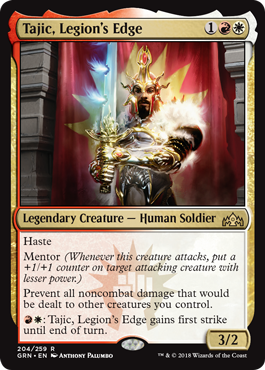
Tajic is incredibly important to the deck thanks to the 3-power he brings to the mentor mechanic. What’s likely to happen is that he’ll attack on turn-3 and pump up a either of your two-drop mentors or maybe a one-drop creature if you missed the curve. The importance of this 3-power can’t be overstated since it can get your mentor checks up and running a turn earlier than normal.
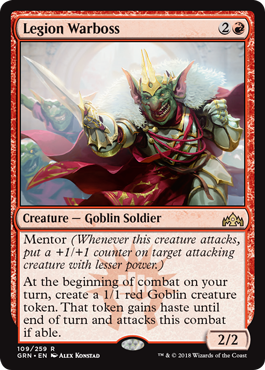
Unimpressive stats that can’t pump up your creatures on its own, but with a mentor on turn-2, Legion Warboss’ free creatures start turning into legitimate 2/2 bodies. On turn-4, it can start attacking as well, spreading the counters further.
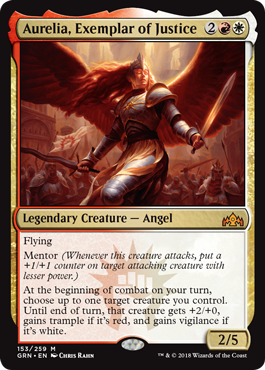
And our biggest DUH moment is Aurelia herself. She effects the board immediately, giving 2-power to any creature, most likely a mentor, which will easily pump up another mentor. On the following turn, should she survive, Aurelia can either attack as a 4/5 or pump up another mentor, become the target of that mentor, and easily attack as a 3/6.
There is no question that when Aurelia is played, your chances of winning the game greatly increase.
Swiftblade Vindicator is a trap, Goblin Banneret is boss
In sticking with our theme of playing only mentors, we have three cards to talk about now. First up:
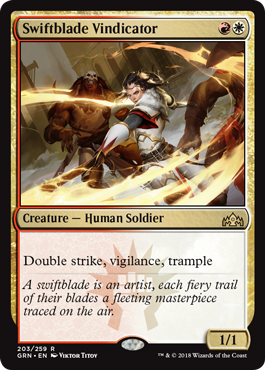
This seems like an easy target for mentor, and it is. I promise. However, I’ve always been unimpressed by it. One, opponents target it immediately for removal, so it’s often a wasted a play. Second, there aren’t enough good 1-toughness creatures for it to block the turn it comes down, meaning it will likely not block that turn if you want it to live.
Third, it doesn’t line up well on the curve since you want to play a mentor on turn-2 and preferably get the mechanic flowing running on turn-3. The earliest Swiftblade Vindicator can be pumped is turn-4… far too late, especially since you want to play Aurelia or another ramp topper than turn.
Last, even when it gets that +1/+1 counter, it still dies to most relevant 4-toughness creatures in Standard, like the drakes or Golgari Findbroker. All that investment… for nothing really. It might seem powerful, but the investment is not worth it. Instead, find a one-drop creature that can be easily pumped early in the game and become a legitimate threat later.
My favorite early targets are:
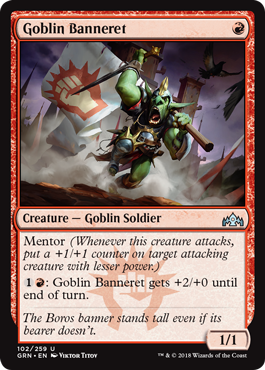
Obviously, Goblin Banneret. This guy is a 1/1 mentor, but he provides some desperately needed versatility with such a one dimensional deck. For example, if you miss your two-drop mentor, his ability can be used to pump up another one-drop creature and still have mana open for Shock or a pump spell.
Later in the game, if you desperately need a strong attacker to finish off an opponent, they aren’t going to ignore an 11/1 goblin charging in, making this a great distraction for the end of the game.
It’s not the best card in the deck, but you’ll always be happy to play this on turn-1, especially if you have our other two-drop creature in hand.
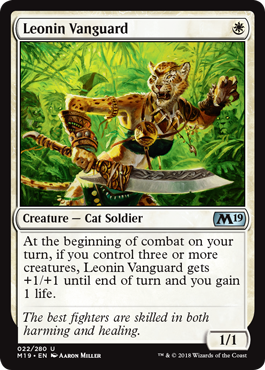
Leonin Vanguard is a much more effective card than the Swiftblade Vindicator. When played on turn-1 or turn-2, it gets in for early damage, which is always nice. On turn-3, with a Goblin Banneret or Boros Challenger on the board, it becomes a 2/2 with a mentor check. If all your creatures survive past that point, it gets an automatic +1/+1 with three creatures on the board, making it a legitimate 3/3 threat that gains you life every turn.
Just remember, always play them BEFORE combat. I sometimes forget.
Between Goblin Banneret and Leonin Vanguard, you have an easy choice of one-drops that help at any point of the game. Play them and benefit from their versatility. Ignore Swiftblade Vindicator. It’s too weak, to easy of a target for opponents, and gets the ball rolling way too slow.
Don’t be afraid to send Tajic to his death
As mentioned before, Tajic, Legion’s Edge is vital for this deck to get mentor counters flowing early in the game. When played on turn-3, it will often pump up a Goblin Banneret, Boros Challenger, or Sunhome Stalwart, which will allow them to be strong enough to pass out more mentor counters on the following turn.

However, you might notice that he’s not exactly strong in the toughness department and dies very easily. 2-toughness is well within range of a Shock, and given how prominent Red is in Standard, that’s likely how he will often die.
He’ll also trade with 2-drops easily, and it’s no fun to see your rare, legendary soldier die to a wimpy merfolk or goblin. Without that first strike ability, he will likely perish in combat, and by the time you can both play him and pay for the ability, your opponent will likely have a four-toughness creature that will kill him anyway.
And you know what? That is totally fine.
Do not fear sending Tajic into battle when he faces certain doom. Using him to pass counters onto your other mentors is far more important than having him live to see another turn. Boros Challenger and Sunhome Stalwart are much more resilient on turn-4 than Tajic is, and they will take the reigns from his mentor counter and easily keep your gameplan flowing.
Triggering mentor every turn is key to winning the game, not the survival of single cards. Tajic, if he dies… he dies.
Aurelia isn’t the only curve topper you want
Aurelia is badass in this deck, no doubt about it. If you play her and she survives into the next round… your opponent will likely just scoop. She can’t be targeted by Cast Down, she survives all Red removal, she blocks some of the formats most dangerous creatures, and she blocks them even more effectively with a mentor counter on her.
But she’s not alone on power level, Another effective card from Magic 2019 will also help you win, possibly on the spot if you’ve hit your curve and an opponent is tapped out.
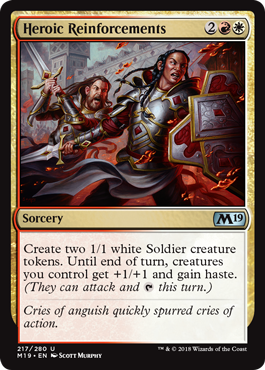
This card is absurd in the Boros Mentor deck. Imagine this…
Turn-1: Goblin Banneret
Turn-2: Boros Challenger
Turn-3: Tajic, Legion’s Edge… attack with Tajic, Boros Challenger and Goblin Banneret… Tajic pumps Boros Challenger into a 3/4, and Boros Challenger pumps Goblin Banneret into a 2/2.
Turn-4: Heroic Reinforcements
Go to combat: Boros Challenger pumps Goblin Banneret into a 3/3, Tajic and Goblin Banneret pump the Soldier tokens into 2/2’s, all of them get an automatic +1/+1 from Heroic Reinforcements, and they swing in for a total of 18 damage. Hopefully, for your opponent’s sake, they left up a blocker.
…
That’s the best case scenario. Most of the time, you’ll have a Boros Challenger and/or a Sunhome Stalwart on the board on turn-4, and with even just two mentors, Heroic Reinforcements causes 12 damage.
On its own, it’s 4 damage, which can close a game, or two bodies which can allow for stabilizing blocks. Great top deck. Great card!
Shock rocks, Integrity rules over Strike
Hitting your curve is important, but if you don’t, you’ll need some form of control to keep your foes at bay. Luckily, Standard is currently overrun with options for Red and White removal, all of which play perfectly into Boros Mentor.
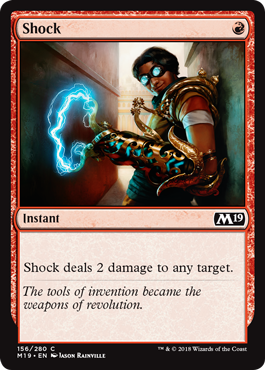
Shock shines best here, even more so than Lightning Strike. The cheap cost of Shock clears out early threats while still allowing you to cast creatures on tempo. Turn-1 Shock or Golin Banneret are both fine plays. Turn-2 Shock and Leonin Vanguard is a perfectly fine play. Turn-3 Boros Challenger and Shock is a very fine play.
Combat goes much smoother if your opponent has nothing to throw in the way of the early creatures you are mentoring, and Shock allows for both efficient removal and a consistent flow of creatures.
Always prioritize creatures over casting Shock, but if your opponent plays something you’d rather not see, consider Bzzzting it away.
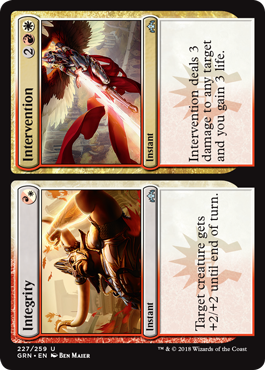
Another card you’ll want to prioritize over Lightning Strike. The versatility in this card is just too powerful to ignore. Integrity alone has four purposes alone that are suiting for this deck:
- Helping creatures survive Red removal
- Pumping creatures as a combat trick
- Pushing through the last two points of damage to close the game
- and most importantly, pumping your mentors before combat to get the mechanic flowing early.
All that for a single hybrid mana. Just sick. Integrity is also effective later in the game if you need to Lightning Helix something away. However, this is a rare case where you might just want to hold on for the cheaper effect.
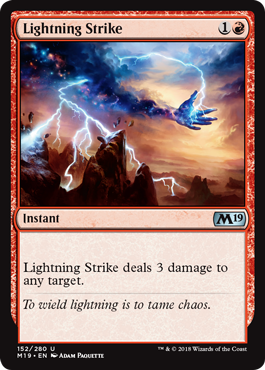
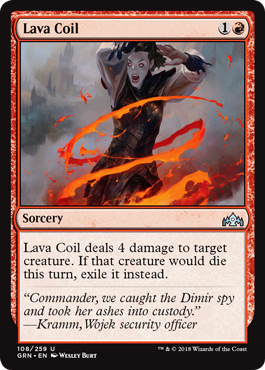
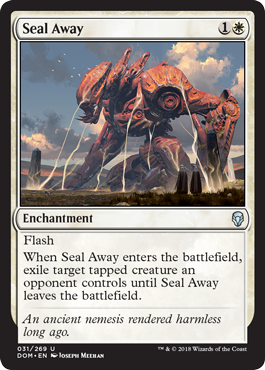
Yes, these three help. Lightning Strike is obviously the card you want the most from these. It kills early and later threats, even if it knocks you off curve a little. Seal Away also makes the main deck since it can take out larger threats like Doom Whisperer and Ghalta so much easier.
Lava Coil is more of a sideboard card here. Don’t put them in the main deck since it similarly knocks you off curve, but don’t be afraid to put it in against Mono-Green, Golgari, or Izzet Drakes. More on that later.
Don’t play Boros Mentor competitively
And now the hard truth… Boros Mentor is not a very good deck. I found this out after sinking all of my free resources from Magic Arena into making my deck, and sadly, I don’t have much motivation to build more decks knowing that grinding for cards was tough enough to build one.
Boros Mentor suffers from poor line-ups in current standard, relies too heavily on hitting a curve, lacks dimensions to get back on track if an opponent plays a single removal spell, and ultimately, isn’t even that fun to play if it doesn’t work out right.
Face it, without the mentor mechanic aligning and working perfectly, you’re just playing a deck of 1/1, 2/2, and 2/3 creatures that can’t stand up to some of the more dominant decks in Magic.
Let’s look at the line-ups really quick:
- Mono-Red Aggro – Sometimes this wins if your opponent can’t get creatures on the board, but the excessive Red removal in Standard means your creatures are all going to be fried. Outside of Aurelia every creature in this deck is susceptible to Lightning Strike, and with the exception of Boros Challenger, every creature is also susceptible to Shock. Just one of these cards can throw your gameplan off, ruin your mentor mechanic, and bring the deck to a stand-still.
- Izzet Drakes – None of the creatures you play, besides Aurelia, will be powerful enough to get past Enigma Drake or Crackling Drake. Rarely, unless you have Heroic Reinforcements or Integrity, will your creatures exceed 4-power in this deck, meaning the drakes block perfectly and rarely trade if they do. Meanwhile, your opponent is drawing cards, frying your creatures with burn spells, or countering with counter spells… and each of these spells is both safer and more efficient than mentor at making creatures stronger.
- Golgari Mid-Range – This is an okay match-up if you hit the curve perfectly, but you have to go first and play your bomb on turn-4. Otherwise, Ravenous Chupacabra easily crushes your best creature, knocking you off curve or Golgari Findbroker effectively blocks anything you throw at it. The lack of trample in Boros Mentor also means you won’t be able to push over Izoni’s bugs.
- White Weenie Lifegain – Decks based around Leonin Vanguard, Ajani’s Welcome, Ajani’s Pridemate, and Resplendent Angel gain more than enough life to offset your creatures, and the Angel tokens will eventually overpower you.
- Wildgrowth Walker Explore – A single explore trigger puts these creatures of reach of your weenies, and the lifegain is often too much to overcome.
- Heck, Aurelia is even susceptible to being captured by Connive when playing against Surveil decks… you want to talk about a back-breaking play.
Boros Mentor loses to all of the top tier decks, and yet, the match-making in Magic Arena calcuates that it has enough rares and mythics to go head to fight with them. Be ready to lose. My ranking has already dramatically increased after leaving Boros Mentor in the dust.
